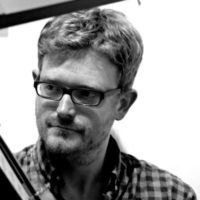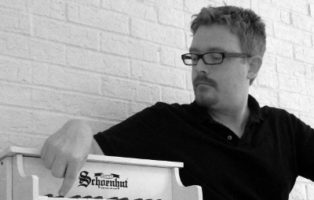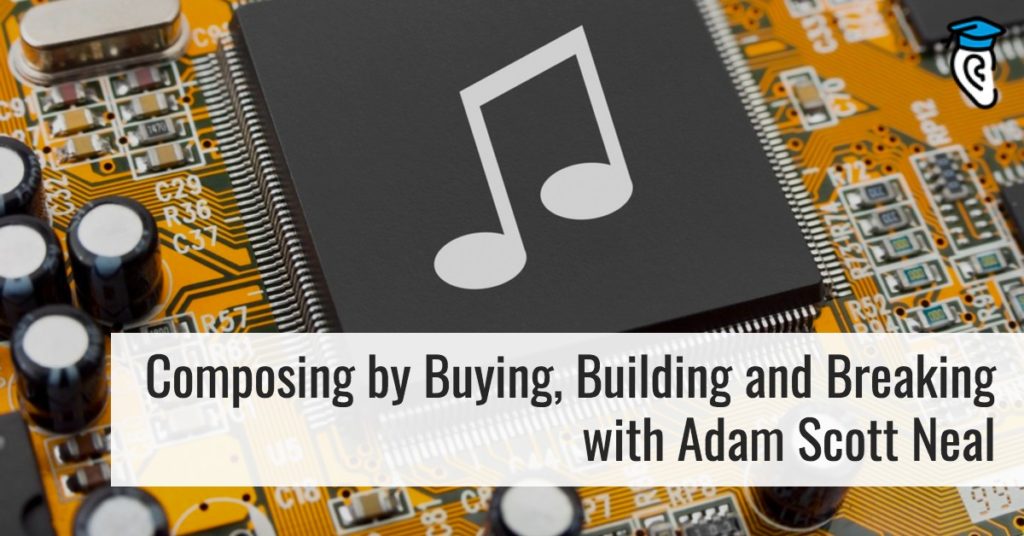Have you wondered what makes modern classical music sound the way it does? Do you feel limited in your own composing or song-writing, and wish to break beyond the traditional “rules” to discover your own unique sound? Adam Scott Neal is an American composer, video artist, and improviser whose eclectic works feature traditional instruments, household objects, and “hacked” electronic toys to create inspiring (and distinctively modern) music.
We invited Adam to join us and share a bit about his composition practice, modern listening skills and the advice he would have for aspiring composers today.
Before we dive in, you can watch a compilation of some of Adam’s recent works:
Q: In what ways would you say that active listening and training your musical ear have guided your development as a composer?
 Ear training is essential to every musician. I feel fortunate to have studied both traditional ear training (sight-singing, rhythmic and harmonic dictation, etc.) as well as music technology. In my audio classes, for example, I learned about frequency bands — which sound muddy, which sound harsh, etc. This has helped me not only to produce recordings, but to think about orchestration in general. In both ear training methods, one learns how notes/pitches/frequencies fit into larger wholes.
Ear training is essential to every musician. I feel fortunate to have studied both traditional ear training (sight-singing, rhythmic and harmonic dictation, etc.) as well as music technology. In my audio classes, for example, I learned about frequency bands — which sound muddy, which sound harsh, etc. This has helped me not only to produce recordings, but to think about orchestration in general. In both ear training methods, one learns how notes/pitches/frequencies fit into larger wholes.
It’s an attitude thing, perhaps. If you’ve grown up on songs, with words conveying stories and emotions, it can be difficult to jump to completely abstract sounds. It helps to have a little guidance in what to listen for, or perhaps even what pieces to listen to first. Beethoven’s Fifth Symphony not only has an opening which most people recognize, but it’s a fine example of motivic development that’s easy to follow.
For experimental music, it may be easier to start with more experimental rock and work your way towards abstract music. A lot of contemporary composers worked that way — we grew up on rock and found our tastes gradually getting more esoteric! Growing up, I became fascinated by the little details of audio production (I am a huge fan of The Beatles, Queen, and Pink Floyd, among others) — I think that prepped me for listening to classical and experimental music, which are quite “detail-oriented”.
YouTube remains a great resource for discovering music. The “up next” list can turn you on to various related pieces. One great channel to check out is Incipitsify. These videos follow the scores of contemporary classical pieces — even for those who don’t read music, the visual representation can be an aid to listening.
It’s funny that you ask, because laptop ensembles were all the rage from around 2007 to 2011, then the interest seemed to drop off sharply. There are still some around but I don’t hear about them as often.
What interested me at the time (2008) was finding a balance between composer control and performer freedom. During the process I was also intrigued by network interaction. One of my compositions, Presets, had a “lead” laptop that searched for settings on another player’s laptop, then sent that setting to everyone. You might be playing high pitches, then all the sudden they are filtered out and you are forced to play lower pitches.
”There are limitless possibilities for performing with computers”
The laptop orchestra (usually part of a class at a university) might have been a bit of a fad, but there are limitless possibilities for performing with computers. A number of people create alternative controllers so they can use more natural body gestures to control music (check out the New Interfaces for Musical Expression conference for more on that). Typing and moving the mouse isn’t all that musical most of the time — not to mention that there’s little for the audience to watch (if that’s important).
There is definitely a place for pencil-and-paper composition. All of my drafts and sketches for acoustic pieces are done that way. I don’t think we’ll get tired of hearing or playing wind, string, and percussion instruments any time soon.
Being tech savvy is perhaps more important on the “business” side of composition. Even if one makes the most clear and beautiful pencil scores, they still need to scan the documents and make copies or a PDF to distribute the work. Making and editing recordings, maintaining a web presence — these are all vital to promoting one’s work.
 In short, “buying” means that composers use objects for their unique qualities. I wrote quite a bit about toy pianos and theremins, for example. Both have unique sonic characteristics, as well as developed semiotic associations (childhood, science fiction).
In short, “buying” means that composers use objects for their unique qualities. I wrote quite a bit about toy pianos and theremins, for example. Both have unique sonic characteristics, as well as developed semiotic associations (childhood, science fiction).
“Building” looked at composers who create new instruments, either to elicit new sounds or ways of playing, or simply from the joy of making an object. Since music is so ephemeral, there is a different kind of satisfaction from creating a physical object. Two examples I studied were Harry Partch and Mark Applebaum.
I was equally intrigued with hacking and “breaking” objects to make new instruments. The “prepared piano” is almost a different animal from the normal piano. To prepare a piano, one inserts screws, erasers, and other objects between the strings. These create all sorts of different timbres, and it sounds more like a percussion ensemble. I also wrote about the Texas Instruments Speak & Spell toy, which is very popular in the circuit-bending community. Circuit benders open electronic toys and deliberately short-circuit them to create new sounds.
Most of my pieces in the last 5 years or so have been directly inspired by the objects they were composed for. Something about intonation, a mechanical quirk, a specific technique. I wouldn’t say that everyone should do this, but that’s what grabs me. And this may work better in abstract instrumental composition than songs.
I’m flattered to hear that I’m breaking new ground, though I don’t see it that way myself. I’m well aware that I am recycling ideas and techniques from others; my goal is to incorporate them into my aesthetic viewpoint.
My first advice is probably similar many other composers’ advice: listen more, read more, experiment more. Often this is said as a way to expand one’s horizons, but I look at it a bit differently. Knowing what’s possible can be as much about what you don’t incorporate into your music as it is what you do incorporate. In other words, composers should know what they value in music, what intrigues them most, what draws them in.
Are you into rhythm? What about it — complex polyrhythms, off-kilter meters, hypnotic pulsation? Are you really fascinated by harmony? What about it — a sense of new and unpredictable harmonies (atonality)? Recognizable chords with non-traditional juxtapositions? And so on.
While I work in eclectic media, I see some common interests: static and (relatively) consonant harmony, a focus on texture and timbre, slow and deliberate pacing, soft dynamics, repetition with subtle variations, etc. These are fairly broad characteristics, so I haven’t yet felt limited by them.
You can learn more about Adam Scott Neal on his website, follow him on Twitter and hear his music on YouTube. You can listen to a performance of Adam’s latest album, Interiors, on Bandcamp:
Are you feeling inspired to get more creative with your own composing? Maybe you can incorporate some new objects or technologies into your latest creation, or explore exactly what it is that excites (or bores) you in the songs you love, to better understand your own ideal aesthetic. Whatever your next step might be, make sure you take Adam’s advice: Listen more, read more, experiment more!


 Click to tweet
Click to tweet




